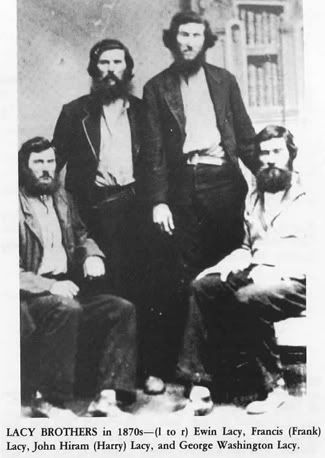The Saga of the Original Lacy Hog Dog

Letter written by Helen Lacy Gibbs on Feb. 8, 2000
Growing up in the depression was an experience that I hope to never have to live in again. We were quite fortunate to live on a ranch and have our own cattle, hogs, chickens and by-products of these to help through that hard time.
My grandfather, George Washington Lacy, Jr., came to Burnet County in 1858, with his brothers, John, Hiram, Ewin, and Frank, from Christian County, Kentucky. After arriving, George and his brothers developed a breed of dog known as the Lacy Hog Dog. They had crossed a hound with a wolf and continued cross-breeding until they had the best dog for working hogs and other stock. George and his brothers were rock masons by trade and raised hogs also to further their income. George and Ewin built the house in Spicewood, Texas before the Civil War, which is still occupied by the Fowler and Faubion families. It is built of limestone, with the gutters being of stone also. The Lacy brothers bought land on the north side of the Colorado River adjacent and in the town of Marble Falls. My grandfather, George, owned Granite Mountain at Marble Falls at the time the Capital at Austin was built and gave the granite for its construction. They began raising hogs for their living and had a packing house in Austin. Their dogs were used to round up the hogs which they took to Austin to be slaughtered. These dogs were invaluable as they were used to “lead” the hogs down the Colorado to the packing house.
I was fortunate enough to help my father, John Henry Lacy, round up hogs on our ranch when I was growing up in the Depression days. We didn’t drive the hogs, we just followed as the dogs led them to the pen. One rider could round up a large number of hogs with just he, his horse and his two dogs. There was a pen in the pasture which the dogs knew to take the hogs. We would go into the pasture, this one being about 1,000 acres, with the dogs and they would locate the hogs and round them up into an area. The dogs would nip the hogs and begin their run toward the pen. The hogs would chase the dogs and when the hogs no longer ran after the dogs, the dogs would return and nip a hog again to begin more chasing by the hogs. This continued until the dogs reached the pen and ran through the open gate with the hogs in wild pursuit. There was a hole in the pen on the opposite side of the gate which was too high for hogs to go through but which the dogs could jump through and escape the hogs. The riders just followed the hogs to the pen and shut the gate, thereby penning the herd with no trouble or danger to the horsed or riders. This is still very vivid in my mind’s eye even 65 years later. This is the same way the hogs were taken to Austin to the packing house -- led by the dogs, followed by the riders.
These dogs are working animals and are never happier than when working stock. When my Dad and I use to come in for lunch and rest a short while, the dogs rested in the shade under a “rain water tank”. When Dad would say “Guess we had better get back to work”, those dogs came alive and were barking and ready to go to work.
We always had at least two working dogs a time -- an older one and a young one learning from the older. They were either red or blue dogs as the Lacy dogs were and are known as. They are faithful to their owners and never happier than when helping to round up stock.
I never go to know my grandfather as he died in 1906, but my father, born in 1879 and died in 1973, told me many stories about these dogs. I was fortunate enough to be able to experience many of the things he told me about his days as a cowboy and using these wonderful dogs. There were 13 children in my grandfathers family, but only 5 came and stayed in Burnet County. During the Depression my father received letters from Kentucky, West Virginia and other places asking information on where they could purchase a Lacy dog to use in rounding up wild hogs in their areas.
I feel fortunate that I had these experiences and heard the stories of the Lacy Hog Dogs through my life. My father had a most unusual mind which was quite alert until the day he died. He was asked many times by younger people around Marble Falls about certain areas and where different things had been and always knew where and what information they needed. He was born and reared in Marble Falls or within 10 miles of the town. So to my father and grandfather, I say “Thanks for a wonderful legacy."
